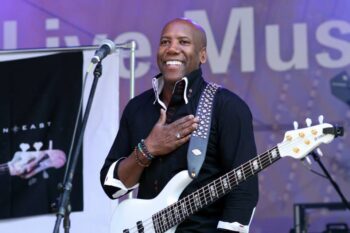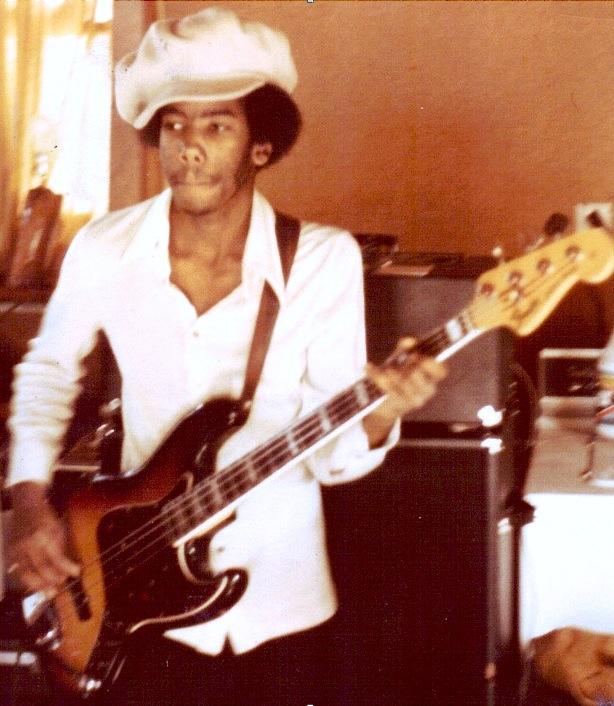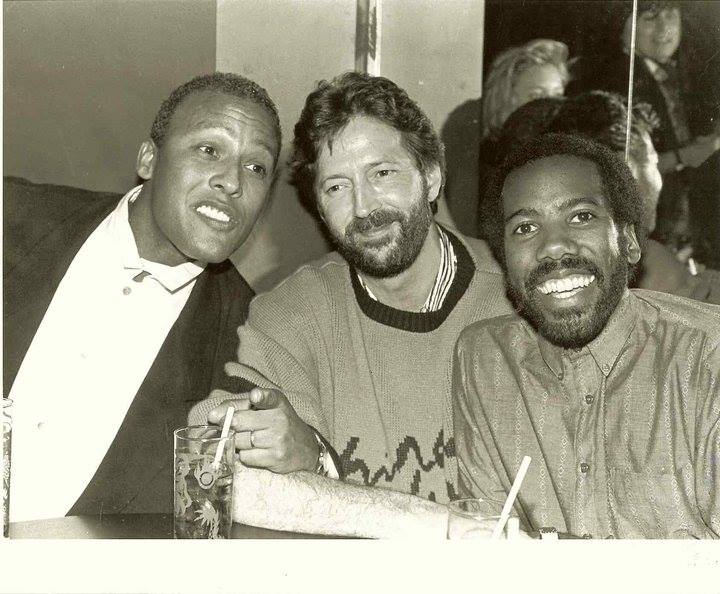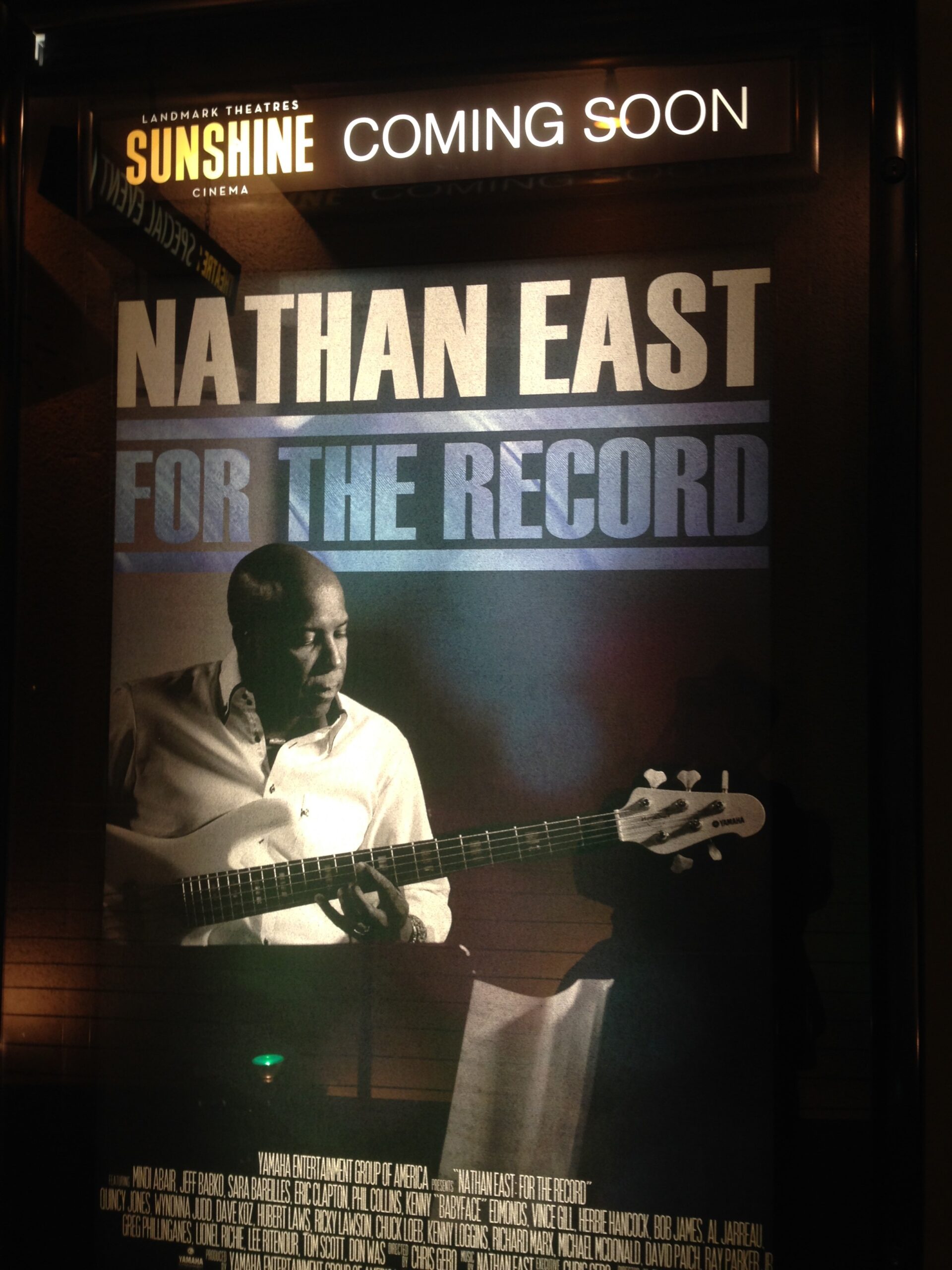
Welcome back to Sound & Vision, the Rumpus profile series that spotlights the creative talents of those working behind the scenes in the music industry. In this installment, I’m really excited to talk with the extraordinarily talented and versatile bassist Nathan East. Only sixteen years old when he got his first break as part of Barry White’s touring band, East has since worked with legendary artists including Eric Clapton, Phil Collins, George Harrison, Michael Jackson, Quincy Jones, Whitney Houston, Beyoncé, Barbra Streisand, Kenny Loggins, Anita Baker, Lionel Richie, Justin Timberlake, Stevie Wonder, Babyface, and Daft Punk. He’s also a member of the chart-topping jazz quartet Fourplay, with whom he’s collaborated for over two decades.
With over 2,000 recording credits to his name, East is one of the most sought after bass players of all time. After decades as a prolific sideman, he released a self-titled solo album this past spring, which debuted at number one on the Billboard Contemporary Jazz chart, and is currently nominated for a Grammy for “Best Contemporary Instrumental Album.” East is also the subject of the new documentary Nathan East: For the Record, which premiered last month on Hulu, and he will be inducted into the NAMM Hall of Fame this month for his technical and creative achievements. When he’s not busy playing, writing, or producing music, East is also a dedicated bass teacher—anyone can sign up for online lessons!
***
The Rumpus: How did you first come to the bass?
Nathan East: Cello was my first instrument—I started playing at Horace Mann Junior High School in San Diego. I was eleven at the time and looking for something to play. I was inspired by the music of Vince Guaraldi, particularly his playing on the Charlie Brown TV specials. When I asked about piano at school, I was informed that only string instruments were available for study in orchestra. The viola and violin were too small, and I was a little guy so the upright bass was too big. I had to take my instrument back and forth to school! So I started on cello and that led to the bass—the electric bass. I played both the electric and upright bass in high school.
Rumpus: And then at the tender age of sixteen you went out on the road?
East: Yes, tender! But I remember it like it was yesterday, playing the Apollo Theater and Madison Square Garden in New York City with Barry White.
Rumpus: How did you first connect with him?
East: Barry was one of the many artists who performed a Stax review concert held in San Diego. I was in a band called Power that was hired as the backup band for all the artists. Barry was so impressed with us that he hired the entire group right on the spot to be his touring band! He invited us to his office in LA and  offered up $500 a week, and we were just slapping hands, giving each other high fives! We just thought it was the coolest thing ever!
offered up $500 a week, and we were just slapping hands, giving each other high fives! We just thought it was the coolest thing ever!
Rumpus: What were those early shows like?
East: You’re in a tuxedo playing with the Love Unlimited Orchestra, a sixty-piece full-on orchestra in front of sold-out arena audiences. You can only imagine a sixteen-year-old kid looking at this and thinking, “What’s not to love!” It was great. I was with my friends, and also my brother David, who was playing guitar.
Rumpus: What did your parents make of this gig?
East: Well, I think I was the youngest guy in the band, but David was older and he was always there to look after me. It was just this exciting surreal, magical thing. At the time Barry White was a mega artist and he was packing arenas throughout the country.
Rumpus: Did you know then and there that you wanted to pursue a career as a professional musician?
East: Pretty much. But I went to college and majored in music, mostly because although my parents loved music, they encouraged me to further my education and were of the philosophy that you should always have something to fall back on. And my grandmother said to me, “If you do just one thing for me, finish college.” UCSD was primarily a science-oriented school, but they did have a great music program and my old professors are still my dear friends to this day.
Rumpus: Did you tour much during your semester breaks?
East: Yes. I would play every chance I got. One of the tours with Barry White cut into one of the semesters, so I took a little bit of time off but my professors were supportive. The only gig that was tricky, and I had to turn it town, was with John McLaughlin. He called me three weeks before I was about to graduate and said, “I need you in New York on Friday.” All my friends were like, “You’re going, right?” But my beloved grandmother, who never heard of any of these famous musicians, still had the one request: “If you do just one thing for me, finish college.”  For her and my folks, I had a lot invested. So I turned him down. Everyone thought I was nuts, but John did call me again when he was in San Diego and I got to meet him to hear the band, and he’s a friend.
For her and my folks, I had a lot invested. So I turned him down. Everyone thought I was nuts, but John did call me again when he was in San Diego and I got to meet him to hear the band, and he’s a friend.
Rumpus: After you graduated, did you tour, pursue studio work, or do a little bit of both?
East: I got into studio work right away and started recording with Barry White almost five days a week. He just lived in the studio! I’d go to LA and record during the day, and then go back to San Diego and play gigs at night, like at the Hilton Cargo Bar and other clubs.
Rumpus: When you collaborate with someone over a long period of time, as you’ve done with Barry White or Eric Clapton, I imagine you develop an intuitive sense of how to make the song together. But from the very start of your career you’ve worked with such a diverse array of artists. When you approach a new partnership, what’s the most important factor in making it work?
East: One of the things I’ve always focused on is my relationships, musically and personally. In the words of Quincy Jones, you “check your ego at the door.” It’s not only about getting the call for the gig but getting the call back for the next gig. Eric Clapton, Kenny Logins, Phil Collins, Al Jarreau were all once first calls. To this day I am still friends with and can still go back to the people and places from the earliest days of my career.
Watch Nathan and Eric Clapton perform “Change the World” live:
Rumpus: In addition to the solo artists you’ve collaborated with, you’ve also been with your own quartet, Fourplay, since the early ’90s. How did you get together?
East: Bob James was putting together a rhythm section for one of his albums. Harvey Mason and Lee Ritenour were both friends of his and each recommended me as a bassist, which was pretty cool. When we all played together for the first time on Bob James’s album Grand Piano Canyon, there was so much magic as a quartet that Bob suggested we form as a group. I call it the first Fourplay record. We’ve been together for more than two decades now, and are currently recording our 25th anniversary album. It’s scheduled for release sometime in 2015. We’re calling it Silver.
Listen to “101 Eastbound,” which Nathan co-wrote with his brother Marcel. The song appeared on Fourplay’s debut album. iPad/iPhone users click here:
[soundcloud url=”https://api.soundcloud.com/tracks/180690058?secret_token=s-4dK0a” params=”color=ff5500&auto_play=false&hide_related=false&show_comments=true&show_user=true&show_reposts=false” width=”100%” height=”166″ iframe=”true” /]
Listen to Nathan’s reimagining of “101 Eastbound,” on his self-titled solo album. iPad/iPhone users click here.
[soundcloud url=”https://api.soundcloud.com/tracks/180690494?secret_token=s-CdSS6″ params=”color=ff5500&auto_play=false&hide_related=false&show_comments=true&show_user=true&show_reposts=false” width=”100%” height=”166″ iframe=”true” /]
Rumpus: And speaking of collaborations, of course we also have to talk about Daft Punk…
East: [Laughs] Of course. That was really fun. They called me in early 2013. I’m a fan of their music, but at first I was thinking, Why are these electronic guys calling me? Then I got to the studio and saw the LA session aces: John Robinson, Paul Jackson, Jr., Chris Caswell, and Mick Guzauski engineering at the recording console. The guys in Daft Punk said they really wanted to go retro and they had all these old Roland synthesizers, analog tape machines, et cetera, set up. It’s rare to go in and play as if you’re in the ’70s. It was really a call out of the norm and very experimental. What a great call to get! You go in to work and try to leave some good notes on tape. Then they took a couple of the songs to New York and put Omar Hakim on drums and Nile Rodgers on guitar and brought in Pharrell Williams. And when they brought “Get Lucky” back to LA there was so much energy coming from Niles’s part that I had to redo the bass part! I was sort of channeling Bernard Edwards (bassist from Chic) on all those great old Chic songs to get that tight percussive tone, so punchy and active. So we turned the tape, recorded a few passes, and all of a sudden this song took on a life. I remember everyone in the studio was dancing around.
Watch Nathan performing “Get Lucky” with Daft Punk at the 2014 GRAMMY show:
Rumpus: You’ve co-written, recorded, and performed on thousands of songs. When I think about some of the big pop hits like “Footloose,” “Easy Lover,” and “Would I Lie to You?,” the bass is very assertive. When people think of a band, they often picture the singer because he or she is right out front, and maybe the guitarist if they’re shredding it up, but the bass is often a little less in the spotlight. How do you approach playing so that you really bring the bass out and up front?
East: I was drawn early on to bass lines from songs like “Day Tripper” by The Beatles and “My Girl” and “Get Ready” by The Temptations. You could just identify the songs from those bass lines. Having studied so many of those great bass lines, when I was making my own music I was always looking for something that would drive the song.
Rumpus: In addition to driving other artist’s songs you’ve also recently put out your first solo album, which is up this year for a Grammy for Best Contemporary Instrumental Album. Was that recording process very different for you than it was playing bass for other artists?
East: The process was actually very similar—a gathering of friends and songs, just this time they’re coming to my living room to play on my album instead of vice versa. They call this a solo album but for me this was just a celebration of music with friends that I’ve made music with for over thirty years. We started with about fifty songs and whittled them down, recording about half of those, and then selecting about half of those for the final cut.
Rumpus: There are so many diverse influences on the album, including reinterpretations of songs you’ve previously played in earlier stages of your career.
East: Yes. As a matter of fact, I remember singing “Moondance” in the first band I was ever in.
Rumpus: And your son also plays on one of the songs on this album.
East: Yes, my son Noah is playing piano on “Yesterday”—he came by the studio and was practicing a beautiful arrangement of the song and my co-producer Chris Gero heard it and said, “that has to go on the record.”
Rumpus: How old is Noah?
East: Fourteen—he was thirteen at the time of the recording.
Rumpus: No pressure! Right?
East: [Laughs] Noah has been playing for about five years now, and he has perfect pitch and an amazing ear. Imagine, I used to change his diapers and now it’s just great to play music with my son!
Watch Nathan and Noah record “Yesterday”:
Rumpus: Do you prefer to record music live as an ensemble, or for each musician to record separately where everyone does his own tracks solo and the songs get mixed together later?
East: For me, the live recording is a conversation that always makes a complete, spiritual, musical statement. It’s the group energy, a select combination of artists all trusting each other in a moment in time that will never happen again in that same way. When you’re on your own you can play as many times as you want till it’s “perfect” but most times the results are much better when you’re a bit vulnerable and in the flow in real time with other musicians—and sometimes the first take is the best. The magic and adventure is always better than just perfection.
Rumpus: As I understand it, some of your recording process was captured in your new documentary Nathan East: For the Record, which is now screening on Hulu.
 East: Chris Gero is a great filmmaker as well as a music producer and label executive. He had cameras rolling from day one of making this album. After about a year there were thousands of hours of footage to work with. In the documentary, he tells the story of making this record as well as the larger relationships I’ve formed with other musicians over the years. It also touches on my family life.
East: Chris Gero is a great filmmaker as well as a music producer and label executive. He had cameras rolling from day one of making this album. After about a year there were thousands of hours of footage to work with. In the documentary, he tells the story of making this record as well as the larger relationships I’ve formed with other musicians over the years. It also touches on my family life.
Rumpus: Can we talk a bit more about your signature bass; I mean the actual instrument?
East: Oh yeah!
Rumpus: I only know a little bit about the bass, but I always thought of it as a four-string instrument. I notice that you’ve played with five strings, sometimes six. What gives?
East: [Laughs] I started with four strings, but in the early ’80s guys started playing five string basses and that was giving them a lower range, then six strings started letting you go lower and higher. In terms of effects, I like a little delay on the more melodic solos. I sometimes use a looper pedal for fun. But for the most part I just plug my bass straight into an amp and play.
Rumpus: And I understand that you’re now teaching others to play?
East: Yes. A few years ago I teamed up with ArtistWorks to offer online bass lessons. Students can be anywhere in the world as long as they have an Internet connection. My curriculum features hundreds of lessons from beginner to intermediate and advanced. From tuning and simple exercises to playing chords and playing in different genres, the lessons are self-paced. The main feature is the student/teacher video exchange where students send me videos of themselves playing and then I respond personally to the work they submit.
Rumpus: Wow. Is there a cap on enrollment? Or is an enormous throng of students emailing their homework to you just as you’re about to step onto a stage to perform?
East: Well, there’s a queue.
Rumpus: Perhaps I’m just projecting my own student email management anxieties onto you! [Laughs] But with your solo album doing so well and the documentary now out, it’s going to be pretty hard for you to maintain a low profile. Worlds are likely to collide.
East: [Laughs] That’s okay. I’m all about education and I think it’s really cool when some of my students come to a show and I get to meet them in person!
***
BONUS MATERIAL
Watch Nathan and guitarist Paul Gilbert step up to the “One Chord Challenge,” where they jam for over seven minutes in “A”—to date this video has had over a million hits:
***
Image of Nathan East documentary poster at Sunshine Cinema by Allyson McCabe. All other images courtesy of Nathan East.
This interview has been edited and condensed. If you’d like to recommend someone for “Sound & Vision,” drop Allyson a line here.




